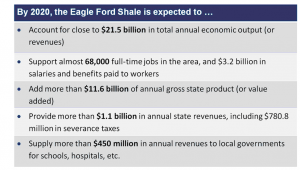May 2011, Vol. 238 No. 5
Features
Midstream Development Is Vigorous In Eagle Ford Shale Play

Since the 2008 discovery of Hawkville Field in south Texas, the Eagle Ford Shale has experienced a tremendous amount of activity. In less than three years, the shale play has become a significant portion of the region’s economy.
Figure 1 shows the estimated economic impacts of the Eagle Ford Shale in 2010. Within the 24-county area that spans South Texas, Eagle Ford Shale activity accounted for roughly 6% of the area’s Gross Regional Product (GRP) in 2010, created close to $1.3 billion of gross state product impact, supported 12,600 full-time jobs and added $2.9 billion in total economic output (revenues). (Author note: Gross state product is also named Value Added. For presentation purposes in this article, this value is presented as contributions to the gross state product rather than to the gross regional product (GRP).)
With more than 300 wells operating in the area, production from the Eagle Ford Shale reached nearly 5.9 million barrels of oil and condensate in 2010, which is a more than 615% increase over 2009 production levels. This high-yield condensate and oil production, combined with a favorable business climate, are very attractive to individual operators who are likely to play a key role in spurring economic development and contributing to the prosperity of the region. With the price of oil above $100 per barrel and natural gas prices near record lows, oil and condensate will drive production in the area and serve as the catalyst for economic activity.
Pipeline Infrastructure
Substantial growth of shale activity will only be possible if certain barriers and limitations are alleviated. One of the most limiting factors, especially as it relates to the production of natural gas liquids, is the absence of sufficient infrastructure to process, store and transport the extracted minerals. This is commonly referred to as midstream development and includes the acquisition of right-of-way acreage, pipeline construction and other infrastructure improvements related to the gathering and movement of produced liquids. Though the pipeline infrastructure in Texas is very mature, especially for oil and natural gas, the system needs significant investments to process natural gas liquids.
In 2010, investments in midstream development accounted for an estimated $404.3 million of the total $2.9 billion of estimated output on the region. (Author note: Based on confidential information received by several energy partners in the region and adjusted to reflect publicly available expenditure information, it is estimated $280 million was spent on midstream development.) These expenditures had $188.8 million gross state product impact and supported 3,608 full-time jobs (Figure 2).

Figure 2
Though significant, this may be a conservative estimate of the actual midstream development activities in the region. As more companies flock to the area, the ensuing rise in output will undoubtedly strain the existing infrastructure. The region simply lacks sufficient processing facilities to keep up with increased production, which in effect will create a backlog of producers trying to get their fuels to consumers. In order to fully exploit the shale, improvements need to be made to the existing pipeline infrastructure for natural gas liquids, primarily the addition of interconnectors, compressor stations and gas processing plants.
The good news is that several developers have recently announced plans to further expand the natural gas gathering system in order to handle additional volumes:
- Enterprise Product Partners recently completed the White Kitchen Lateral to connect the center of the Eagle Ford Shale to its existing natural gas pipeline and is constructing a 140-mile, 24-inch oil pipeline to transport oil from the play.
- Energy Transfer Partners announced plans to invest about $300 million to construct a 160-mile, 30-inch gas pipeline and processing plant.
- TexStar Midstream Services LP announced that it will build a 65-mile, 12-inch pipeline with the capacity to move 120,000 barrels a day of crude oil and natural gas from Frio County to Three Rivers.
- Rosetta Resources intends to invest $325 million in midstream capital in the Eagle Ford Shale area.
With more than 130 miles of new pipeline activity, including the continued development of the Chisholm, Dilley, Dos Hermanas, Leona, and Fox Creek pipelines, all indications are that over the next three to five years midstream activities will continue to play a significant role in the development and economic prosperity of the region.
Looking To The Future
With an expanded gathering system and processing capabilities, primarily for natural gas liquids, the activities of the Eagle Ford Shale are projected to account for close to $11.6 billion in gross state product by 2020 – which may be more than 20% of the GRP (Figure 3). In addition, it will account for $21.5 billion in total economic output, and support close to 68,000 full-time jobs in the area. At a time when the State of Texas is struggling with severe budget issues, this will add close to $1.1 billion in state revenue and provide more than $450 million in local government revenues.

Figure 3
Author
Dominique Halaby, D.P.A. is the director of the Center for Community and Business Research at the University of Texas at San Antonio’s Institute for Economic Development. The Center undertakes various projects with differing levels of complexity, from large regional analyses to assisting organizations in strategic planning. He holds a doctor of public administration degree, an MBA and a BA (sociology). He is a member of the Southwestern Economics Association, the Association for Research on Non-profit Organizations and Voluntary Action and the American Society for Public Administration. For more information contact 210-458-2020, link to the full Eagle Ford Shale report: http://ccbr.iedtexas.org.





Comments